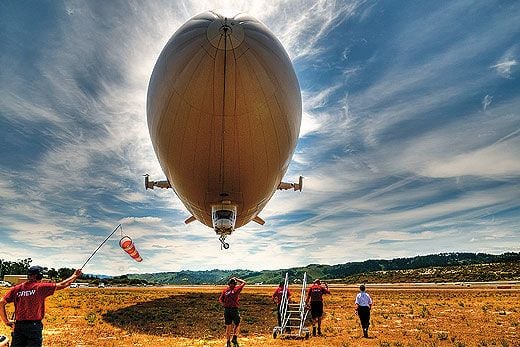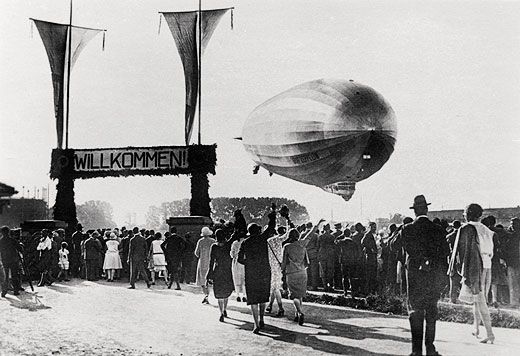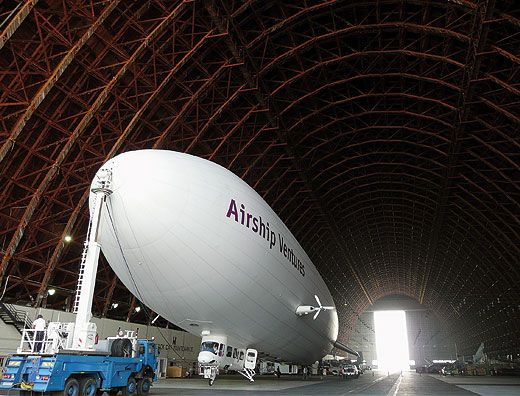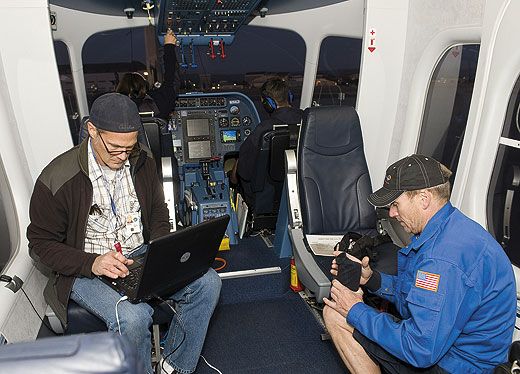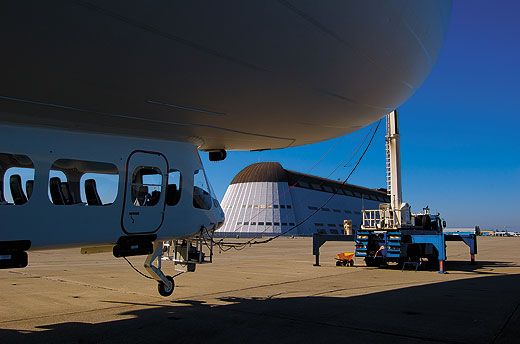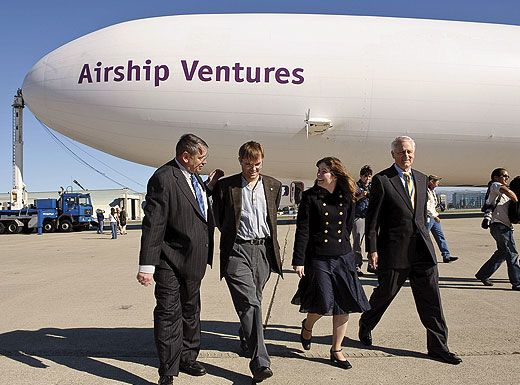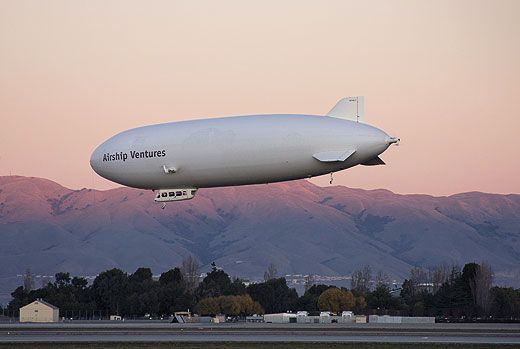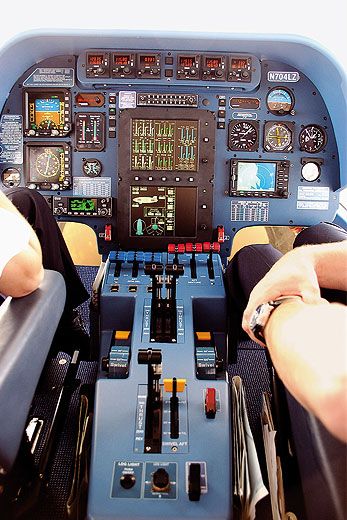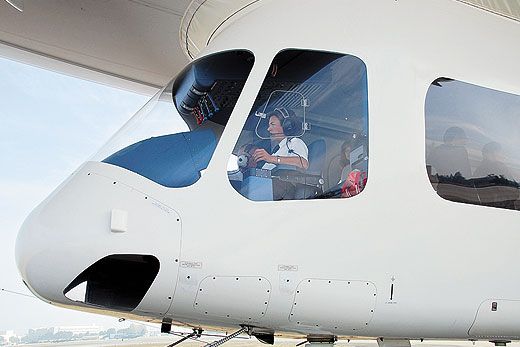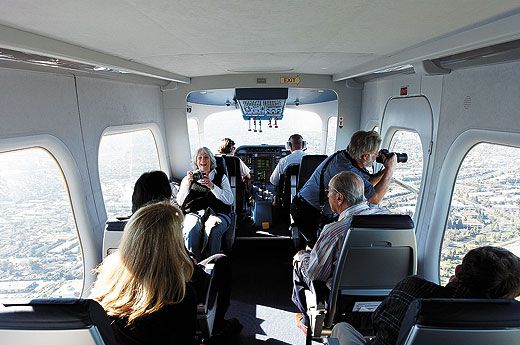Z2
The latest in sightseeing tours, brought to you by Count Ferdinand Von Zeppelin.
/https://tf-cmsv2-smithsonianmag-media.s3.amazonaws.com/filer/FM-2011-Z2-11-FLASH.jpg)
A windless day, sunlight filtered through high clouds. We are about 1,000 feet over south San Francisco in Eureka, the first zeppelin to fly over American soil since the Hindenburg explosion. In the gondola, a team of scientists from NASA’s Ames Research Laboratory in nearby Mountain View observes the hundreds of acres of coastal ponds below, a patchwork of vivid green, orange, and red.
Each pond has been isolated by levees from the action of tides; as the water in the ponds evaporates, a residue of salt is left behind. For a hundred years, the salt has been harvested by the Cargill Company. Now, a 15,000-acre parcel of this land has been returned to the state of California, to be restored to wetlands.
Eureka crisscrosses the ponds following precisely plotted tracks on its GPS. This is one of a series of flights over the area. "We’re part of a larger group that’s looking at the ecology of the [San Francisco] bay as we turn it from a salt pond back into a wetland," says Rocco Mancinelli, an Ames expert on halophiles, bacteria that thrive in extreme salinity. They hope to ease the disruption of the species that have adapted to the salty ponds.
The zeppelin has already demonstrated great promise for use in scientific research. Flying over Monterey Bay, it has studied how algae blooms can poison wildlife and has also tracked the route of a pipeline in an effort to detect how gas leaks underground change plant life on the surface.
The very qualities that make Eureka an outstanding airborne scientific observation platform—stability, maneuverability, lack of vibration, and ability to stay aloft for long periods and at low airspeeds—also make it superb at its day job: carrying sightseers on tours over California coastal regions, including San Francisco, Los Angeles, and San Diego.
In the distance we can see NASA’s Moffett Field, where three historic hangars for lighter-than-air craft rise up like monster cathedrals. Hangar One, which 76 years ago housed the Navy airship USS Macon, is now condemned because of toxic waste contamination. Directly across the runway is Hangar Two, Eureka’s home base. Here pilot Jim Dexter will ease the airship down to a mooring mast mounted on a truck parked in front of the hangar doors.
Eureka is owned and operated by Airship Ventures, Inc., founded by the husband-and-wife team of Brian and Alexandra Hall, president and chief executive officer, respectively. Brian, the founder and head of a Silicon Valley company, had always had an interest in flying. "I did start out my software career doing aviation software," he says. Alex, who has a degree in astrophysics, had directed the Chabot Space and Science Center in Oakland, California.
Brian, whose business trips often take him to Europe, became aware that an offspring of the original zeppelin company was stirring in Friedrichshafen, Germany. It was here, in 1900, that Graf (Count) Ferdinand von Zeppelin flew his first lighter-than-air craft. Over the years, 119 zeppelins were produced in the town.
The company that manufactured the original zeppelins, the ZF Group, is today a prosperous worldwide conglomerate, making automotive transmissions and steering and drive components but, for more than six decades, no zeppelins. Production of those ceased when the Hindenburg memorably exploded at Naval Air Station Lakehurst in New Jersey in 1937. After that, the world lost its appetite for zeppelins.
But in 1988, an event triggered the zeppelin’s rebirth. Friedrichshafen was celebrating the 150th anniversary of the count’s birth, and had asked the count’s great great grand nephew, Wolfgang von Zeppelin, a ballooning enthusiast, to fly his balloon during the celebration. In an e-mail from Germany, Wolfgang describes the genesis of a new generation of zeppelins: "I piloted the balloon," he says, "and my guest of honor in the balloon basket was the newly elected mayor, Bernd Widmann."
For von Zeppelin, Widmann was the right man in the right place. The count had created a foundation to take ownership of his airship factory, and, since shortly after the end of World War II, the town of Friedrichshafen has controlled the foundation. "It was a wonderful flight over Lake Constance and the Alps," says von Zeppelin, the manager of research and design for a manufacturer near Stuttgart, "so I proposed to the mayor to undertake an open-minded investigation to find out whether a renaissance of airships makes sense.
"As an engineer, I told him that it was technically possible to build and fly airships that would carry passengers without risk. In my opinion, airships showed the most promise for tourism and would enable many people to share what he had just experienced in this balloon basket. Widmann suddenly understood." In 1993, a new company, Zeppelin Luftschifftechnik GmbH, was founded in order to produce a prototype.
The first operational new-generation zeppelin, NT 01 ("NT" for New Technology), built with von Zeppelin’s close involvement, made its debut flight on September 18, 1997, the 69th anniversary of the maiden flight of Graf Zeppelin, LZ127, the airship that inaugurated the world’s first regular transatlantic air service. The NT used inert helium, safer than the flammable hydrogen of the old zeppelins.
Ten years later, Friedrichshafen, as the first NT zeppelin was called, was just completing a two-year contract for DeBeers, exploring for diamonds in Botswana, when a freak whirlwind destroyed it while it was on its mast.
Meanwhile, a second zeppelin, Bodensee (the German name for the country’s Lake Constance), had been built and was sold to a Japanese company, which used it to carry advertising before going bankrupt last year. A third, Baden-Württemberg, flies sightseeing tours in Germany. Number 4 was just beginning construction when Brian Hall decided to take a closer look.
In 2006, while in Cologne at a computer conference, he booked a ride on zeppelin NT 3. "I kind of did it like a secret shopper," he says. "I just went and flew, and I had that ‘Eureka’ moment. I knew this was the business we had to do."
ONE MORNING before flight operations begin, Matthew Kilkerr, Airship Ventures’ technical manager and chief inspector, treats me to a closer look at Eureka and its Moffett nest.
Because of a wartime shortage of steel, Hangar Two was built over a frame of redwood beams. During World War II, it housed blimps, which the United States used for minesweeping, recon, submarine patrol, and other missions. Today, one end of the cavernous, vaulted hangar is reserved for Eureka, with enough space remaining for another five zeppelins of its size.
Among the special equipment needed for Eureka’s care is a 20-foot container housing a helium purifier. "A compressor will draw out helium, which will then go through a membrane which removes the impurities, and the helium will be pumped back in," Kilkerr explains. (Impurities degrade the zeppelin’s lifting ability.)
We walk around the ship. The hull, or envelope, is composed of polyurethane-coated multi-laminate polyester fiber. Inside, Kilkerr says, "from the nose of the ship to the tail are three aluminum longerons—two come along the sides of the airship and one along the top." Attached perpendicular to the longerons are 14 triangular graphite-reinforced plastic frames. The new zeppelins are 246 feet long, and have only four percent of the maximum volume of the old ones.
In the old zeppelins, the lifting gas was contained in separate cells; in the new, the helium fills the whole envelope, except for two large bags called ballonets, which are filled with air. The pilot can trim the ship by changing the amounts of air in the two bags, or by shifting fuel from the aft tank to the midship tank, or vice versa.
The three engines are 200-horsepower Lycoming IO-360Cs, the same series that powers the Piper Arrow light airplane. The variable-pitch props are 106 inches, more than half again as long as the standard Piper Arrow propeller. As a result, they operate at a lower rpm than the props of conventional aircraft.
Even with three engines, the zeppelin NT is remarkably stingy with fuel. At cruise speed, it uses about 15 gallons an hour, only a little more than the single-engine Arrow.
Every morning before the first flight, a crew chief brings a large aluminum suitcase filled with electronic sensors to the airship and, standing outside the envelope, hooks it up to through-hull connectors. The device reads and records the air volume in the ballonets; the temperature, pressure, purity, and dew point of the helium; and the temperature and dew point of the outside air. It then comes up with an equation describing the buoyancy of the airship. That measure is e-mailed to the pilot, who can then decide, given the load factors of the mission, whether to add helium. The same data is available during flight on a display in the instrument panel.
"I can use the information to do my weight and balance and preflight activity, which is computerized," says Jim Dexter, Eureka’s director of flight operations. "Then it helps me to manage my trim, where I need to put my fuel."
Dexter came to Airship Ventures with 27 years of commercial lighter-than-air experience, all in blimps. Compared with airplanes, Dexter says, blimps, which have no internal framework, "are much harder to manage and operate. The zeppelin, because of its high degree of maneuverability, is a joy to fly. The pilot has direct control throughout the entire operation, from launch to recovery."
Kate Board, presently the only woman zeppelin pilot in the world, observes: "Flying by feel in a blimp, you have wheels and pedals and you’re kicking it around the sky, really. It is very physically demanding. The zeppelin is more mentally demanding to fly."
A takeoff demonstrates the degree of control the pilot enjoys. The airship backs slowly away from the mast by reversing the pitch of the side engine propellers. "Once we get our clearance," says Dexter, "we swivel the main engines up." At this point, each side joystick is controlling the prop pitch and engine vector. The airship ascends vertically. Once clear of ground obstacles, the engines are swiveled to level-flight position, and the joystick input goes directly to the control surfaces on the fins—"barn doors," Dexter calls them.
Strictly speaking, the zeppelin is not lighter than air. "We’re normally operating about 380 kilos [838 pounds] heavy," he says. "As we vector the engines up for landing, we lose aerodynamic lift over the bag, so we start to descend. That’s the ideal configuration for the ship to bring itself down." In a pinch, descent can also be controlled by releasing water ballast, helium, or both.
One day Dexter invited me to sit in the right seat on a flight out of Long Beach airport in southern California. As we cruised at 1,000 feet over the Pacific a half-mile off the breakwater, I told him that one of the things that impressed me was the way he could turn the ship on its vertical axis. He smoothly vectored the engines up to hover and, using the thrust of the aft engine’s side prop, began a long gentle turn to the right. It’s a maneuver the pilots often use for sightseeing passengers who want to linger over a certain patch of landscape—say, their own neighborhood.
The large sloping picture windows give spectacular 180-degree views. Almost directly below, a large pod of dolphins in a feeding spree churned the ocean to white froth.
The roomy gondola (equipped with a head) carries 12 passengers plus two crew members. Sightseers are encouraged to walk around and even stick their heads out of ports in the forward windows in the mild slipstream. The most common description: "Like riding on a cloud."
Janice Martinson, guest services representative, acts as combination tour guide and flight attendant. "We’ve had people who just wanted the experience of floating, people who want to fly over their house," she says. "We’ve had people celebrating birthdays and anniversaries, and some chartered the entire ship for their party. We’ve had people propose. One couple got married aboard while we circled near the Golden Gate Bridge."
Wolfgang von Zeppelin notes that the zeppelin NT Baden-Württemberg, operating in Germany, has already carried more passengers than all the earlier, larger zeppelins did during their period of commercial operation, between 1910 and 1937. The success encouraged him to create a new company, Zeppelin Europe Tours, and he is now raising money to build an airship that can carry 50 passengers on a European sightseeing circuit.
The scientific missions are also increasing. Last summer Eureka took scientists from the Woods Hole Oceanographic Institution in Massachusetts on long flights over the San Juan Islands in Washington state to count and study whales.
Alex Travell, special mission sales manager for Airship Ventures, says the original business plan envisioned five percent of income coming from science missions, but it has turned out to be about 20 percent. "The Jet Propulsion Lab [in Pasadena, California] is interested in measuring the mercury content in the air in the Los Angeles basin," he says. The movement of air masses makes the work difficult, but because the zeppelin is capable of slow, controlled flights, it is uniquely suited to do the sampling. Moreover, some aspects of the study can be economically piggybacked on sightseeing flights.
Stephen Dunagan of the Ames lab manages development of an imaging system used on the airship. On its flights over the coast salt ponds, Eureka carried a high-resolution camera and a hyperspectral scanning imager mounted in a lower section of the gondola; the latter can identify and measure 256 distinct color bands. Dunagan sees a bright future for the airship: "It doesn’t like to go really high"—8,500 feet is the maximum—"but there’s a lot of very interesting stuff that’s happening very low. Most of the chemical exchange with the biosphere and hydrosphere—the various organisms in the oceans and the gas exchange chemistry at the surface of the oceans—all that is happening in the lower troposphere"—the lowest layer of the atmosphere.
Eureka continues to work for the scientists at Ames. It has more flights scheduled over the salt ponds, and the data will be correlated with observations from sea level as well as from satellites, which can detect larger patterns of change as the water is desalinated.
Ames’ Rocco Mancinelli hopes the zeppelin flights will help with a second interest of his. A researcher with the Search for Extraterrestrial Intelligence Institute, Mancinelli says: "I’m also interested in Mars. Right now it’s dry, but some time during its past it had water. When it evaporated it formed brine pockets, and what kind of organisms went into these brine pockets?" Mancinelli thinks that the zeppelin flights could detect patterns in the south San Francisco ponds suggesting the kinds of microbial life that might have once lived on the Red Planet.
It’s not something Count von Zeppelin would have considered: that his airships would evolve from serene carriers of passengers and mail to vehicles enlisted in the study of life on Mars.
Marshall Lumsden died last November, while this article was being prepared for publication.
